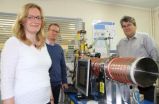(Press-News.org) Barcelona, Spain – Monday 1 September 2014: Permanent atrial fibrillation (AF) doubles the risk of stroke compared to paroxysmal AF, according to research in more than 6 000 patients presented at ESC Congress today by Dr Thomas Vanassche from Belgium. The findings suggest that a simple clinical assessment of the type of AF can help doctors to better estimate stroke risk.
Ischaemic stroke is the second cause of death in the EU, accounting for over a million deaths and many more disabled patients each year. Annual direct health care costs amount to more than €20 billion. AF is a frequent rhythm disorder and an important risk factor for stroke (1). The presentation of AF can vary from short and often self-limiting episodes of arrhythmia in people with otherwise normal heart rhythm, called paroxysmal AF, to a continuously abnormal rhythm called permanent AF (2).
Dr Vanassche said: "Our study shows that the risk of stroke is higher in patients in whom the arrhythmia is present permanently, compared to patients who only have short episodes of arrhythmia, even when correcting for other stroke risk factors. Although it may seem intuitive that the continuous presence of AF carries a higher stroke risk than short, intermittent episodes, this has been an area of controversy."
He added: "Although some recent trials have reported higher stroke rates in patients with permanent compared with paroxysmal AF, other studies did not report a significant difference. Current guidelines recommend that the pattern of AF should not be taken into account when assessing the stroke risk in patients with AF, suggesting that, when it comes to stroke risk, 'any AF is AF'."
To address this question, the researchers pooled data from two previously conducted clinical trials, ACTIVE-A and AVERROES, for a combined sample size of more than 6 000 patients with AF. Besides the large number of patients, another important strength of the analysis was that none of the patients were treated with anticoagulant medication, which reduces the risk of stroke. In contrast to population studies, where it can be difficult to detect and verify all strokes, all events in the trial were rigorously detected and adjudicated.
The researchers found that patients with permanent AF had an almost twofold higher risk of stroke compared to patients with paroxysmal AF, with a yearly rate of 4.2% compared to 2.1%.
Dr Vanassche said: "Other studies have shown that patients with permanent AF are often younger and at a lower risk of stroke compared to those with permanent AF, and these findings were confirmed in our analysis. Nevertheless, the difference in risk of stroke remained significant when correcting for other risk factors such as age, heart failure, diabetes, sex, prior stroke, hypertension, and peripheral artery disease."
He added: "The higher risk of permanent versus paroxysmal AF was also seen when considering patients with low, intermediate, or high risk of stroke separately."
Dr Vanassche continued: "It is very important to acknowledge that regardless of its form and presentation, AF increased the risk of stroke. Therefore, all patients with AF should be assessed for risk, and if the risk is sufficiently high, they should be treated with anticoagulants. Thus, our results strengthen the existing recommendations."
He concluded: "On the other hand, these results do provide support for the intuitive notion that 'a lot of AF' carries more risk than 'a little AF'. In cases where there is doubt about whether a patient would benefit from anticoagulant therapy, the presentation of AF could be one of the additional factors to take into account."
INFORMATION:
References
(1) In a normal heart, each heartbeat is the result of an electrical signal generated in the sinus node, the heart's natural pacemaker. This signal spreads through the heart in a coordinated way causing a synchronized contraction of the atria, which pump the blood into the heart ventricles. A fraction of a second later, the electrical signal reaches the ventricles and pumps the blood from the heart through the body. Atrial fibrillation (AF) is the condition when the normal electrical activity of the heart atria is replaced by a chaotic electrical signal. The resulting very rapid, irregular and uncoordinated contractions prevent any effective pump function of the atria. The loss of coordinated pump function, together with changes in the atrial wall, promotes the formation of blood clots in the heart. When these clots shoot off and block arteries in the brain, they can cause a stroke.
(2) AF can present in different ways. One of the most obvious classifications can be made based on the simple observation of whether the arrhythmia is present continuously or intermittently. Many patients with AF have a normal heart rhythm for most of the time, but present with short, self-limiting episodes of arrhythmia. This intermittent pattern of AF is known as paroxysmal AF. In contrast, other patients never return to a normal heart rhythm, and the electrical and mechanical function of the atria is permanently disturbed. Rather than two different diseases, paroxysmal and permanent AF are thought of as different stages of the same underlying process that causes continuing and progressive damage to the atria. As the destruction of normal atrial tissue advances, the arrhythmia progresses from short episodes over longer episodes to, finally, a permanent state of arrhythmia.
Notes to editor
Authors: ESC Press Office
Tel: +34 670 521 210 (ESC Spokesperson Coordinator – Tanya Kenny)
Email: press@escardio.org
About the European Society of Cardiology
The European Society of Cardiology (ESC) represents more than 80 000 cardiology professionals across Europe and the Mediterranean. Its mission is to reduce the burden of cardiovascular disease in Europe.
About ESC Congress 2014
ESC Congress is currently the world's largest international congress in cardiovascular medicine. ESC Congress 2014 takes place 30 August to 3 September at the Fira Gran Via congress centre in Barcelona, Spain.
This press release accompanies both a presentation and an ESC press conference at the ESC Congress 2014. The press release has been written by the investigator and edited by the ESC and does not necessarily reflect the opinion of the European Society of Cardiology.
EMBARGO: Monday 1 September 2014 at 16:30pm CEST
SUBMITTED TO A SCIENTIFIC JOURNAL: no
SPONSOR: Sanofi, BMS and Pfizer
REFERS TO SESSION: State of the Art - New insights into prevention of thromboembolic events in atrial fibrillation
http://spo.escardio.org/SessionDetails.aspx?eevtid=69&sessId=13821
More information available on ESC Congress 365 after the scientific session: slides and webcast when available (http://congress365.escardio.org/)
Permanent AF doubles risk of stroke compared to paroxysmal AF
2014-09-01
ELSE PRESS RELEASES FROM THIS DATE:
A nucleotide change could initiate fragile X syndrome
2014-09-01
Researchers reveal how the alteration of a single nucleotide—the basic building block of DNA—could initiate fragile X syndrome, the most common inherited form of intellectual disability. The study appears in The Journal of Cell Biology.
Fragile X syndrome is caused by a defect in a gene on the X chromosome called fragile X mental retardation 1 (FMR1). Around 1 in 230 women and 1 in 360 men carry a so-called premutation, in which a series of DNA repeats at one end of the FMR1 gene is slightly longer than normal. These repeats are prone to even further expansion when ...
Scientists call for investigation of mysterious cloud-like collections in cells
2014-09-01
WASHINGTON — About 50 years ago, electron microscopy revealed the presence of tiny blob-like structures that form inside cells, move around and disappear. But scientists still don't know what they do — even though these shifting cloud-like collections of proteins are believed to be crucial to the life of a cell, and therefore could offer a new approach to disease treatment.
In the Journal of Cell Biology, two researchers are issuing a call to investigators from various backgrounds, from biophysics to cell biology, to focus their attention on the role of these formations— ...
Zooming in for a safe flight
2014-09-01
As nocturnal animals, bats are perfectly adapted to a life without light. They emit echolocation sounds and use the delay between the reflected echoes to measure distance to obstacles or prey. In their brains, they have a spatial map representing different echo delays. A study carried out by researchers at Technische Universität München (TUM) has shown for the first time that this map dynamically adapts to external factors.
Closer objects appear larger
When a bat flies in too close to an object, the number of activated neurons in its brain increases. As a result, ...
Week-long meeting on naming algae, fungi, and plants recorded for posterity
2014-09-01
The week-long discussions and decisions of the Nomenclature Section of the XVIII International Botanical Congress took place in Melbourne, Australia in July 2011. This meeting is held every six years and it is where the world's premier experts on the rules for naming algae, fungi and plants get together to debate and update the rule book for naming the organisms they study. This is the primary product of the meeting, the International Code of Nomenclature for algae, fungi, and plants, which was published in 2012. The other important product is the official report for the ...
Scientists get set for simulated nuclear inspection
2014-09-01
Some 40 scientists and technicians from around the world will descend on Jordan in November to take part in a simulated on-site inspection of a suspected nuclear test site on the banks of the Dead Sea.
Playing the part of inspectors, the experts will have access to a wide range of sensor technologies to look for signs of whether a nuclear explosion has taken place. At the same time, other role-players representing the state under inspection will try to put them off their scent.
The aim of this elaborate exercise, as science writer Edwin Cartlidge explains in this month's ...
Invisible blood in urine may indicate bladder cancer
2014-09-01
New research which finds that invisible blood in urine may be an early warning sign of bladder cancer is likely to shape guidelines for clinicians.
Scientists at the University of Exeter Medical School found that one in 60 people over the age of 60 who had invisible blood in their urine (identified by their GP testing their urine) transpired to have bladder cancer. The figure was around half those who had visible blood in their urine – the best known indicator of bladder cancer. However, it was still higher than figures for other potential symptoms of bladder cancer ...
Sugar substance 'kills' good HDL cholesterol, new research finds
2014-09-01
Scientists at the University of Warwick have discovered that 'good' cholesterol is turned 'bad' by a sugar-derived substance.
The substance, methylglyoxal - MG, was found to damage 'good' HDL cholesterol, which removes excess levels of bad cholesterol from the body.
Low levels of HDL, High Density Lipoprotein, are closely linked to heart disease, with increased levels of MG being common in the elderly and those with diabetes or kidney problems.
Supported by funding from the British Heart Foundation (BHF) and published in Nutrition and Diabetes, the researchers ...
New tuberculosis blood test in children is reliable and highly specific
2014-09-01
A new blood test provides a fast and accurate tool to diagnose tuberculosis in children, a new proof-of-concept study shows. The newly developed test (TAM-TB assay) is the first reliable immunodiagnostic assay to detect active tuberculosis in children. The test features excellent specificity, a similar sensitivity as culture tests in combination with speed of a blood test. The promising findings are a major advance for the diagnosis of tuberculosis in children, particularly in tuberculosis-endemic regions.
The study has been published on Sept 1st, 2014 in Lancet Infectious ...
Scientists develop 'electronic nose' for rapid detection of C. diff infection
2014-09-01
A fast-sensitive "electronic-nose" for sniffing the highly infectious bacteria C. diff, that causes diarrhoea, temperature and stomach cramps, has been developed by a team at the University of Leicester.
Using a mass spectrometer, the research team has demonstrated that it is possible to identify the unique 'smell' of C. diff which would lead to rapid diagnosis of the condition.
What is more, the Leicester team say it could be possible to identify different strains of the disease simply from their smell – a chemical fingerprint - helping medics to target the particular ...
Why plants in the office make us more productive
2014-09-01
'Green' offices with plants make staff happier and more productive than 'lean' designs stripped of greenery, new research shows.
In the first field study of its kind, published today, researchers found enriching a 'lean' office with plants could increase productivity by 15%.
The team examined the impact of 'lean' and 'green' offices on staff's perceptions of air quality, concentration, and workplace satisfaction, and monitored productivity levels over subsequent months in two large commercial offices in the UK and The Netherlands.
Lead researcher Marlon Nieuwenhuis, ...




